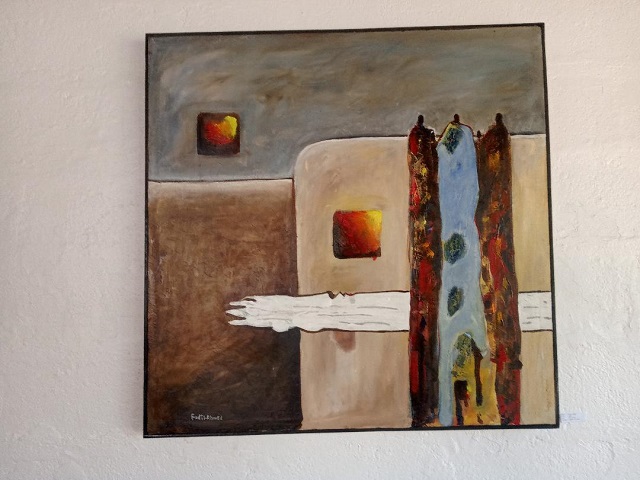
Tales from Sudan Exhibition interrogates Sudan’s rich and diverse culture while fostering dialogue and challenging perceptions about this North African Country.
ART | DOMINIC MUWANGUZI | Sudanese artists are no stranger to the Uganda Contemporary art scene. In the early 2000s, a group of Sudanese artists came to Uganda after their successful stint in Nairobi, Kenya and while the others returned to Kenya, one artist, Ahmed Abushariaa permanently stayed in Uganda. Since that time, Ugandan artists have adopted certain elements in their neighbour’s art like veiled women motifs, boxy shelters and moon symbols, which they occasionally use to convey particular messages in their artistic productions. But more so, such exchange has fermented cordial relationship between Ugandan art institutions- including galleries and Universities- and artists from this North African country. Tales from Sudan, by Fadil Ahmed, a youthful Sudanese artist who recently completed his Masters Degree in Fine Art at Margeret Trowel School of Industrial and Fine art, echoes this type of relationship. Now showing at the Makerere Art gallery, the exhibition focuses on the cultural and historical heritage of the people of Sudan, while providing a deeper lens on how the current social and political landscape is influencing the lives of people of this vast nation.
Sudan is home to more than 500 ethnic grouping with a multiplicity of languages and religions which make it an interesting but complex venue to interrogate in terms of the intricate differences in cultural and religious practices. The painting, Identity 2024, tackles this subject of wide raging identity in the country that serves a dual purpose of uniting the people while at the same time creates a sense of awareness to individual communities to preserve what distinguishes them from the rest. The artist deployment of different Arabic iconography like calligraphic designs suggest the diversity in religion and culture the people relish from time immemorial. In another painting, Home before 2024, the artist depict an abstract composition of three women wearing veils- a typical dress-code for women under the Sharia law. The three women figures are bonding closely; a symbol of communal living that is typical in many communities of Sudan.

“Among the different ethnic groupings in Sudan, if you are not married regardless of age, you have to live within your parents’ compound,” says Fadil. According to the artist, this traditional formal setting of communities is under threat today because of the advent of new cultures. The artist figuratively represents this message in his painting by painting two geometric shapes in sizzling colours of red and yellow on the left-hand side of the canvas. The blistering palette is a metaphorical representation of a fire that is burning in the shelter and is causing the inhabitants of the settlement to disintegrate. The three women figures are a representation of the central position women occupy in many Sudan communities. Culturally, women are at the center of the family unit where they perform important household duties. Nonetheless, her vital role in the community has in the recent past been challenged by the Islamic law where she’s relegated to the periphery of society.
In essence, the abstract work on display in one part of the gallery confront the theory of ‘art for not art’s sake’. The artist uses the technique of vibrant hues and bold strokes to capture the attention of his audience towards the different theme’s he’s navigating in his work. In this, he assumes an identity of a social-political activist through his abstract paintings who quietly is challenging the status quo but also at the same is mindful of not taking the propagandist stance. Equally, the story telling technique used by the artist to convey his message inspire an aspect of sincerity and authenticity. This is mostly observed in his realistic water colour paintings in the other part of the gallery. The latter paintings possess a calm and relaxed ambience, largely fostered by their rustic compositions like a waterfall in the countryside, a boy riding on a donkey on their way to fetch water and a solitary Arab man seated quietly selling sandals.
It is easy to see the strength of this exhibition that goes beyond celebrating the diverse cultural and historical heritage of the people of Sudan. The artist’s deliberate attempt not to be confrontational in his work- despite his unfortunate circumstances of living as refuge in another country- is highly commendable. While the artist does nor shy away from the complex realities prevailing in his home country, he otherwise creates a balance between the two worlds- past and present- leaving his audience to make their own interpretation of the showcase. Nonetheless, this exhibition brings to mind the critical role art can play in critiquing social, cultural and political ailments in society without being necessarily aggressive. With such an approach, everyone is effectively engaged and enlightened on the critical issues at hand. A deeper and sustainable conversation can definitely emanate from this artistic engagement leading to better problem solving.
*****
The exhibition is showing now at the Makerere Art gallery located within the school campus of Margeret Trowel School of Industrial and Fine art, Makerere.
 The Independent Uganda: You get the Truth we Pay the Price
The Independent Uganda: You get the Truth we Pay the Price



